
The Eleazer Arnold House is a historic house built for Eleazer Arnold in about 1693, and located at 487 Great Road, Lincoln, Rhode Island in the Great Road Historic District. It is now a National Historic Landmark owned by Historic New England, and open to the public on weekends.

The Fleur-de-Lys Studios, also known as Fleur-de-Lis Studios or Sydney Burleigh Studio, is a historic art studio, and an important structure in the development of the Arts and Crafts Movement in the United States. It is located at 7 Thomas Street in the College Hill neighborhood of Providence, Rhode Island. It was designed by Sydney Burleigh and Edmund R. Willson, and built in 1885. It was declared a National Historic Landmark in 1992.

The Nightingale–Brown House is a historic house at 357 Benefit Street on College Hill in Providence, Rhode Island, United States. It is home to the John Nicholas Brown Center for Public Humanities and Cultural Heritage at Brown University. The house is architecturally significant as one of the largest surviving wood-frame houses of the 18th century, and is historically significant as the longtime seat of the Brown family, whose members have been leaders of the Providence civic, social, and business community since the 17th century, and include nationally significant leaders of America's industrialization in the 19th century. The house was listed on the National Register of Historic Places and declared a National Historic Landmark in 1989.

The Corliss–Carrington House is a National Historic Landmark house at 66 Williams Street in the College Hill neighborhood of Providence, Rhode Island. Built in 1812, it is significant as a high-quality and well-preserved example of a Adamesque-Federal style town house.

Eisenhower House, formerly known as the Commandant's Residence or Quarters Number One of Fort Adams, is a historic house that is part of Fort Adams State Park in Newport, Rhode Island.

The Samuel B. Conant House is an historic house at 104 Clay Street in Central Falls, Rhode Island. This 2-1/2 story structure was built in 1895 for Samuel Conant, president of a Pawtucket printing firm, and is one of the city's finest Colonial Revival houses. Its exterior is brick on the first floor and clapboard above, beneath a gambrel roof punctured by several gable dormers. The main facade has two symmetrical round bays, which rise to the roof and are topped by low balustrades. A single-story porch extends between the center points of these bays, and is also topped by a low balustrade.

The Aylesworth Apartments are an historic apartment building at 188-194 Broad Street in Providence, Rhode Island. It is a 2-1/2 story structure, built in brick on the first floor, and with its upper floors finished in slate. It has a busy roofline, typical of the Queen Anne style popular when it was built in 1888-89. Its main entry is recessed under a large round archway which also has a small second-story porch under it. The building originally housed four apartments, but was altered in 1978 to house professional offices. It is the oldest known building built as an apartment house in the city.
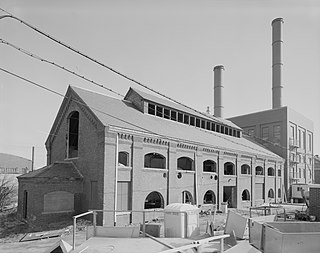
The Chemical Building, Field's Point Wastewater Treatment Facility is an historic wastewater treatment building on Ernest Street at Field's Point in Providence, Rhode Island. Built in 1900-01, it is one of the two oldest buildings at Providence's main sewage treatment facility. It is a 2-1/2 story brick structure measuring 103 feet (31 m) by 38 feet (12 m). The long facades are divided into 9 bays, separated by brick piers. When originally built, the structure had a concrete first floor, a wooden second floor, and a loft area accessed by catwalks, and was used to hold and deliver chemicals used to neutralize the wastewater arriving via the Ernest Street Sewage Pumping Station. In the 1930s the plant was converted to use an active sludge process, and the interior of the building was altered to be a single large chamber.

The Covell Street School is an historic school building at 231 Amherst Street in Providence, Rhode Island. It is a two-story wood frame structure built in a typically elaborate Queen Anne style. Although it is basically rectangular in plan, its roofline and exterior are busy, with a complicated group of cross gables, hip-roof sections, with projecting and recessed sections. A three-story square tower rises from the center of the main facade. Built in 1885 and opened in 1886, it is one of Providence's last surviving 19th-century neighborhood school buildings. It was designed by the local firm of William R. Walker & Son, designers of many Rhode Island civic buildings. The builders were John L. Sprague & Company.
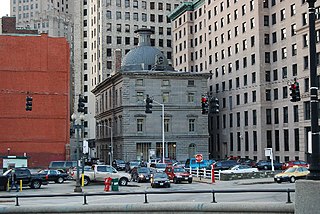
The Customhouse Historic District is a historic district encompassing fifteen historic buildings in downtown Providence, Rhode Island. The district is bounded by Westminster, Exchange, Dyer, Pine, and Peck Streets, and includes eight buildings associated with the important functions of the business center Providence became in the mid-to-late 19th century. It was listed on the National Register of Historic Places in 1975, and is completely contained within the Downtown Providence Historic District, listed in 1984.

The Elizabeth Building is a historic commercial building at 100 North Main Street in the College Hill neighborhood of Providence, Rhode Island. The five-story masonry building was built in 1872 for noted local developer Rufus Waterman. The building was designed by Alfred Stone and is one of Providence's few surviving commercial buildings with a cast iron facade. The facade is five bays wide, the bays separated by engaged Corinthian columns, with each floor separated from the next by an entablature with bracketed frieze. The outer bays have paired windows, while the three inner bays have larger sash windows. The decorative elements of the main facade are continued for a bay with paired windows on the left side elevation.
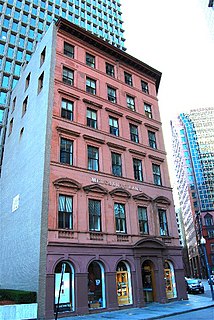
The Merchants Bank Building is a historic commercial building at 32 Westminster Street in downtown Providence, Rhode Island. it is a six-story brownstone structure, designed by Alpheus C. Morse and Clifton A. Hall and built in 1855-57. When built, this Italianate structure was one of the first buildings of Providence's financial district, and is now surrounded by much larger modern skyscrapers. It is architecturally reminiscent of Roman palazzos, with an arcaded ground floor, second-level windows topped by alternating segmented-arch and triangular pediments, and a projecting cornice with dentil moulding and modillions. The building served as the headquarters of the Merchants Bank until it merged with Providence National Bank in 1920.

The Providence Telephone Company is an historic commercial building at 110-116 Union Street in downtown Providence, Rhode Island. Now a five-story brick, stone, and terracotta structure, it was built with three stories in 1893 to a design by Stone, Carpenter & Willson. The street level facade is limestone, with a three-part entrance bay and two smaller flanking bays. The entrance bay is partititoned by Ionic columns, and the smaller outer bays are flanked by Corinthian columns. A complex entablature of grotesquework separates the second and third floors. The fourth and fifth floors, added in 1906, are more simply treated, with a simple parapet at the top. The Providence Telephone Company, incorporated in 1880, occupied this building from its construction until 1917, by which time its rapid growth had outgrown the building's capacity.
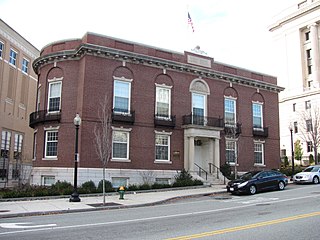
The Rhode Island Medical Society Building is a historic commercial building at 106 Francis Street in Providence, Rhode Island. It is a two-story brick Federal Revival building, designed by Clarke, Howe & Homer, and built in 1911–12. It has a five-bay main facade and a bowed south-facing bay. The main entrance is recessed under a cast-stone entryway. The Rhode Island Medical Society was founded in 1812, and is one of the oldest medical societies in the nation. The building served as their headquarters from 1912 to 2002. The building was renovated in 2010 and is now occupied by Moran Shipping Agencies Inc.

The Rochambeau Library—Providence Community Library is an historic public library building at 708 Hope Street in Providence, Rhode Island. It is a single-story brick structure with limestone trim, designed by Wallis E. Howe and built in 1930. It has a symmetrical main facade, with the entrance in the center, sheltered by a porch supported by fluted Corinthian columns. The flanking bays are pavilions with gable fronts. A modern two-level addition with a glass front has been made to the north side of the building.

Shakespeare Hall is an historic commercial building at 128 Dorrance Street in downtown Providence, Rhode Island. It is a six-story masonry structure, originally built as a three-story Greek Revival structure in 1838 to a design by Tallman & Bucklin. Its main facade has retained the massive granite pilasters and five-bay configuration from this period. Originally built to house a theater, the building suffered a massive fire in 1844, leaving only its exterior shell standing. It was afterward rebuilt to its present height, and a separate brick building at its rear was incorporated into its structure in the late 19th century. It was used as a warehouse in the 1860s, and has also housed light industrial operations. Today, the building is used largely for law office space.

The Sons of Jacob Synagogue is a historic synagogue at 24 Douglas Avenue in Providence, Rhode Island. It is a two-story brick structure, set on a raised basement. The main facade is three bays wide, with a pair of entry doors sheltered by a simple gable-roof portico. The building was constructed in two stages, 1906 and 1926, and is the major surviving remnant of what was once a large Jewish community in the Smith Hill neighborhood of Providence. The congregation which built it was formed in 1896 by Orthodox Jews who immigrated from Russia. The first stage of the building, its lower level, housed the congregation until it could raise funds to build the upper level, and was then used as a shul. The upper level was designed by Harry Marshak, a self-taught architect and builder born to immigrant Russian Jews, who was likely the first Jewish architect to work in the Providence area.

St. Joseph's Roman Catholic Church is a historic church at 86 Hope Street in Providence, Rhode Island within the Diocese of Providence.

Art's Auto is a historic former service station at 5–7 Lonsdale Avenue in Pawtucket, Rhode Island. It is a single-story brick structure with a flat roof and a series of towers capped by pointed roofs. It was built as an automotive service station in 1927–28 for Arthur Normand at a time when gasoline producers competed, in part, by the shape and style of their service stations. This station is one of two stations known to survive from this period in the state. Its front facade has a dramatic presentation, with square towers topped by pyramidal roofs at the corners, and a projecting round bay in the center topped by a conical roof, with windows arrayed around the bay and on its flanks. The building is currently used as an office for Anchor Financial. Art's Auto was listed on the National Register of Historic Places in 1978.
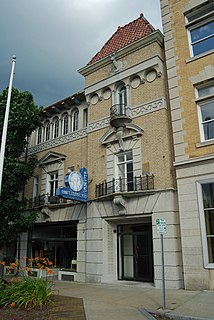
The Pawtucket Elks Lodge Building is an historic site at 27 Exchange Street in the historic central business district of Pawtucket, Rhode Island. The Mission/Spanish Revival building was designed by the O'Malley-Fitzsimmons Company and constructed in 1926. It is three stories in height, with its facade faced in buff brick, laid in Flemish bond, and trimmed in cast stone. Unusual for Elks lodges of the time, the building's first floor was devoted to commercial tenants, with the upper floors devoted to Elks facilities.



























